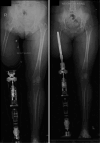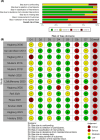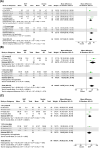Comparison of Quality of Life in Transfemoral Amputee Using Bone-Anchored Prostheses vs. Socket Prostheses: A Systemic Review and Meta-Analysis
- PMID: 40677172
- PMCID: PMC12318688
- DOI: 10.1111/os.70086
Comparison of Quality of Life in Transfemoral Amputee Using Bone-Anchored Prostheses vs. Socket Prostheses: A Systemic Review and Meta-Analysis
Abstract
Amputation has a profound impact on an individual's quality of life (QoL) and functional ability. While socket prostheses are the current first-line treatment, they often cause socket-related issues. Bone-anchored prostheses (BAP) have been introduced to address these problems and improve the amputee experience. This systematic review and meta-analysis aim to compare the QoL between bone-anchored and socket prostheses in transfemoral amputees. A systematic review and meta-analysis were conducted from November 2023 to July 2024, following PRISMA guidelines. Databases including PUBMED, EMBASE, Scopus, Cochrane, and Web of Science were searched. Studies of single-arm trial design comparing pre- and post-operative outcomes were selected based on specific inclusion and exclusion criteria. Statistical analysis was performed using inverse variance with a random effect model. The primary outcome was QoL, measured using the Questionnaire for Persons with a Transfemoral Amputation (Q-TFA) and 36-Item Short Form Survey (SF-36), and the secondary outcome was mobility, assessed by the 6-Minute Walk Test (6MWT). Subgroup analyses compared different types of BAP (Press-fit vs. Screw-type) on QoL. Thirteen NRCTs with 398 participants were included. Significant improvements in QoL were observed in all Q-TFA domains and the SF-36 Physical Component Score (PCS), but not in the SF-36 Mental Component Score (MCS). Mobility improved significantly as measured by the six-minute walk test (6MWT). No significant differences in QoL were found between Press-fit and Screw-type BAP implants. Overall, BAP significantly improve both QoL and mobility, but study limitations currently restrict their use to individuals with socket-related complications. As such, it cannot yet be universally recommended as a first-line intervention.
Keywords: bone‐anchored; mobility; quality of life; socket‐suspended; transfemoral amputation.
© 2025 The Author(s). Orthopaedic Surgery published by Tianjin Hospital and John Wiley & Sons Australia, Ltd.
Conflict of interest statement
The authors declare no conflicts of interest.
Figures






Similar articles
-
How To Improve Patient Selection in Individuals With Lower Extremity Amputation Using a Bone-anchored Prosthesis.Clin Orthop Relat Res. 2025 Jun 1;483(6):1075-1092. doi: 10.1097/CORR.0000000000003369. Epub 2025 Jan 24. Clin Orthop Relat Res. 2025. PMID: 39853312
-
What Functional Outcomes Can Be Expected With Osseointegrated Prostheses in Transfemoral Amputations?Clin Orthop Relat Res. 2025 Mar 1;483(3):513-523. doi: 10.1097/CORR.0000000000003267. Epub 2025 Jan 31. Clin Orthop Relat Res. 2025. PMID: 39898879
-
Does Transhumeral Osseointegration After Amputation Improve Patient-reported Outcomes and Prosthesis Use?Clin Orthop Relat Res. 2025 Feb 19;483(8):1502-1510. doi: 10.1097/CORR.0000000000003420. Clin Orthop Relat Res. 2025. PMID: 39982023
-
Comparison of bone-anchored prostheses and socket prostheses for patients with a lower extremity amputation: a systematic review.Disabil Rehabil. 2017 Jun;39(11):1045-1058. doi: 10.1080/09638288.2016.1186752. Epub 2016 Aug 5. Disabil Rehabil. 2017. PMID: 27494092
-
Systemic pharmacological treatments for chronic plaque psoriasis: a network meta-analysis.Cochrane Database Syst Rev. 2017 Dec 22;12(12):CD011535. doi: 10.1002/14651858.CD011535.pub2. Cochrane Database Syst Rev. 2017. Update in: Cochrane Database Syst Rev. 2020 Jan 9;1:CD011535. doi: 10.1002/14651858.CD011535.pub3. PMID: 29271481 Free PMC article. Updated.
References
-
- Pospiech P., Wendlandt R., Aschoff H.‐H., Ziegert S., and Schulz A., “Quality of Life of Persons With Transfemoral Amputation: Comparison of Socket Prostheses and Osseointegrated Prostheses,” Prosthetics and Orthotics International 45, no. 1 (2021): 20–25. - PubMed
-
- Paternò L., Ibrahimi M., Gruppioni E., Menciassi A., and Ricotti L., “Sockets for Limb Prostheses: A Review of Existing Technologies and Open Challenges,” IEEE Transactions on Biomedical Engineering 65 (2018): 1996–2010. - PubMed
-
- Welke B., Hurschler C., Schwarze M., Jakubowitz E., Aschoff H.‐H., and Örgel M., “Comparison of Conventional Socket Attachment and Bone‐Anchored Prosthesis for Persons Living With Transfemoral Amputation‐Mobility and Quality of Life,” Clinical biomechanics 105 (2023): 105954. - PubMed
Publication types
MeSH terms
LinkOut - more resources
Full Text Sources
Medical
Research Materials

